by Herbert Compton
published in 1904, Grant Richards, London. “Compiled from the contributions of over five hundred experts.”
An aristocrat of aristocrats, the borzoi is at once the noblest looking as well as the newest addition to our bench of sporting hounds. He came with an Imperial halo about him, for amongst the earlier specimens introduced into this country were some from the Czar’s kennels.
The Russian wolf-hound, like its Irish prototype, bears a great affinity to the greyhound. Except for its fleecy coat and feathered tail it is practically built on greyhound lines with certain modifications. The chief of these is in the head, which differs in outline and conformation so much that it is practically distinct from any other breed of hound. The veriest tyro, having once seen it, can recognise a “borzoi head,” with its thin, narrow, Roman-nosed contour, and its long fine muzzle. And yet the grip of these hounds is far in excess of what you would give them credit for, and the boast of their masters in their native land is that we have no hound so tenacious of holding on to its quarry. Perhaps it would be more correct to ally the borzoi to the Asiatic greyhound, the hounds of Persia and Afghanistan, generically, notwithstanding that the Russian has kept the delicate and lightly carried ear – perhaps at the expense of a skull too narrow to contain much brains.
Truth to tell, the borzoi has acquired a character of being less sagacious than other dogs – outside his own sphere of sport, wherein he is peculiarly cunning and adept. I remember hinting this to a lady-fancier, and being crushed with the retort, “Stupid! Not a bit of it! My hound knows its name quite well!” Subsequently, a confession was made that the hound in question was a little rash in the risks it ran of getting run over, and was safer on a lead than when allowed to wander unattached. I trust I am unintentionally unjust to the borzoi, whom I have no desire to libel; but I must confess I retain the conviction that, mentally speaking, it is not a brilliantly witted hound.
But, as I have said, in its own sphere the borzoi is neither lacking in sense nor spirit, and perchance any dog, translated from such outlandish climes as the wilds of Russia to our busy centres of dog-showing, might not be able to adapt itself to its new surroundings and conditions for a generation or two. But the borzoi is being quickly anglicised; it has already ceased to be rare, and has increased marvellously within the last few years. This is reflected in the entries at the Kennel Club Show, which leaped from fifteen in 1900 to sixty-two, fifty-three, and seventy-two in the last three years. An even better proof is afforded by the advertisement columns in the dog-press. Picking up a paper at random I observe a column of borzoi advertisements, with a host of reputed champion-bred stock offered at prices which old fanciers of the breed would doubtless consider scandalous compared with prices current ten years ago, when, in the first blush of its invasion and the sunshine of Royal patronage, to possess a borzoi was to be in the first flight of fashion as regards dogs. Even now, when they are comparatively common, a borzoi at heel invests the owner with a certain distinguished air, which no other breed can do, and I remember an audible remark oerheard at a fashionable sea-side parade in reference to a very meagre specimen that was rather dejectedly following a somewhat seedy-looking individual, “Look! that’s one of the Queen’s dogs!”
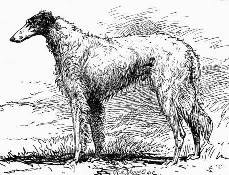
It is probably due to Her Majesty’s interest in the breed that it has achieved this high tone. But, on the other hand, its lovers may insist that its fame is all its own, and due to its undoubted grace and beauty, which must ever continue to attract attention and command admiration. And one fact certainly cannot be denied: the borzoi is one of the most striking-looking dogs in our canine repository, and once seen is more easily recognized than any other. And if there is a certain want of quick intelligence in its glance, a certain languor in its action, these are merged and lost in its harmonious outline and its aristocratic mien, which enable it to comport itself with a lofty indifference to surroundings that is in itself a sort of acme of superiority!
The Russian wolf-hound has the advantage of justifying its name in its own country, where it is still employed in the chase of the wolf, being used in much the same way as the Anglo-Indian uses his Rampur hound or greyhound for jackal hunting, and as Irish wolf-hounds were utilised in the good old days. That is to say, it is essentially a coursing and killing hound – not a hunting one. The actual dislodging of the wolves from their cover is done by a commoner and less aristocratic dog. The borzoi is stationed at a suitable point outside to deal with the quarry after it has been hunted out. When the wolf has been driven into the open, sighted, and allowed a suitable start, – a hundred or two hundred yards, according to the ground and the proximity of the next cover, – then, and not till then, are the borzois slipped, generally in couples, though with noted “fliers” a single hound may be allowed to show itself off. When a couple are employed they approach the wolf from different sides, and on overtaking it await their opportunity until one or the other is able to pin it by the neck just below the ear. The next moment hound and wolf are on the ground, head over heels, – all in a muddle, so to speak. And it is here that the marvellous ability of the hound to hold on comes into play; it never lets go of the wolf; once fixed it is a permanency, until the keeper comes up, who proceeds to slip a muzzle on the wolf, the capture of which alive is the scheme of the chase. If, however, there is any delay the borzoi is quite capable of giving the wolf the coup-de-grace, and has frequently done so, for its hold is the hold of death. And it is a striking fact that the hound rarely if ever gets a scratch in the encounter. The best borzois can, and often do, kill a wolf without assistance, though, as I have said, the design is to take the animal alive in order to utilize it to enter young hounds for the sport. An ordinary adjunct of these wolf-courses is a cage on wheels, in which the captured wolves are carried from the field to provide tuition and entertainment in much the same way as our bagged badgers do. The speed with which the borzoi can travel in pursuit of the wolf requires to be seen to be appreciated, and is second only to that of a good English coursing greyhound.
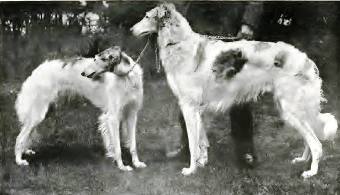
Entered to such savage sport, it is not strange to learn that the borzoi in its native land is accounted a savage animal, and has a reputation of being a terrible fighter in the kennel. The greater its prowess, the more redoubtable its exploits, the more it is prized, and a considerable jealousy exists amongst those who own it, chiefly nobles and persons of rank and wealth, as to the relative merits of their respective strains, which are as keenly fostered and kept pure as are the occupants of noted sporting and hunting kennels in England. Not only the Czar, but many of the Imperial princes of Russia are fanciers of the borzoi, and their strains are the creme de la creme. Mr. Rousseau gave the Queen, when she was Princess of Wales, the famous borzoi Alex, which in 1900 divided honours for the Kennel Club championship. The present borzoi, Gatchina, owned by Her Majesty, and the dam of several winners, came from the Czar’s kennels.
Contrary to the popular belief, it is the smooth coated borzoi which is the most common in England. The Duchess of Newcastle is my authority for saying that the rough borzoi (Goustopsovy), even in Russia, is scarcer than the smooth (Psovy); both come in the same litter at times. A real rough coat, as seen on the imported hound Kaissack, is almost an unknown thing in England, and those who did not see this specimen cannot realize in the least what it was like. The imported hound Korotai also had a very heavy coat, but it was not so good in mixture, being coarser. Kaissack, however, never grew so good a coat as the one he landed with. The same applies to Sverkay, a dog at present in the Clumber kennels. He landed with a coat the equal of Kaissack’s, but now, although good, it is not what it was. The heaviest coated specimens that have been bred in this country have been sired by Kaissack or Korotai or their descendants.
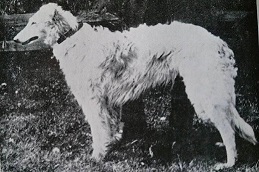
The average height of our show-bench borzoi is about 30 inches, though one gigantic specimen, Caspian, measured 34 inches. The colours are white, splashed with lemon, red, fawn, grey, and occasionally darker shades, but black and tan is tabooed. Expatriation has decidedly improved the borzoi’s disposition, and it cannot be regarded as anything but a very docile creature in its English domicile, though it retains its inveterate habit of chasing anything that appears to it to be of the nature of a warrantable quarry, and for this reason requires looking after in its walks abroad.
Before recapitulating the criticisms on the type of the breed as it exists in England today, I will reproduce two descriptions of “ideal dogs,” so that a mental picture may be represented to my readers’ eyes of the exceedingly beautiful subject of this sketch.
THE DUCHESS OF NEWCASTLE’S IDEAL BORZOI – A perfect borzoi should show substance combined with quality. A long head, rather Roman-nosed; dark, almond-shaped eyes, soft and expressive, set half-way between the occiput and point of nose; small ears, set on high, but not prick; a strong neck, which should appear rather short in proportion to the size of the hound; well set-back shoulders, sloping to the points; well sprung ribs (but not round, like a barrel); deep chest, arched loin, stern set low. Very strong muscular quarters, so that, standing behind, they appear the widest part of the hound; hocks well bent and let down; stern long and carried low; long, silky coat, white, and should curl slightly on the neck; legs straight and well feathered; the bone and muscle on legs should not appear round, but flat. Feet rather long, with not too much bridge to the toes. Height from 29 to 32 1/2 inches.
MISS HELEN ARNOLD’S IDEAL BORZOI – My ideal only exists in fancy at present, but some day I hope to exhibit him to the public. He shall be about 33 inches high, with a lovely, long, curly, silky coat, waving up round his ears with quite a Queen Elizabeth ruffle, to set off a head 13 1/2 inches long, with a skull 16 1/2 inches in circumference, flat on top, and oval to the sides. The skin on his head will be so thin and the hair so fine that his veins will be perceptible all down his aristocratic “Wellington” nose. His eyes will be very dark and penetrating; his ears small, thin, and always alert when exercising, but tightly folded back when at ease. When he is fully furnished his chest will measure 3 inches more in circumference than his height; his ribs will not resemble a “weather-board,” but he will be “fish-sided.” There will be room for his heart to beat and his lungs to expand, so that I may not lose this dream of years (when I get him!) by sudden failure of the heart’s action. He will cover as much ground as his height, and will be wider behind than in front, owing to his sloping, muscular hindquarters. He will have a strong but not too short neck, and a sloping shoulder; his stifle well bent, his hind legs brought up nicely under him, owing to a good roach back, which roach will be a harmonious curve, not a camel’s hump of a thing. His long tail and his hind and fore-quarters will all be well feathered with long, silky hair; the bone of his fore legs will be flat, gradually tapering down to his hare feet, which must be this shape in case some day duty calls him to his proper work, which is, in winter, on the snow; and I should like him to meet his Russian brothers on equal terms. His temper will be generous and kind, and he will be equally happy in house or kennel; always willing to share his bed and food with his companions, as all mine do now. I hope his colour will be white, with deep auburn markings, shading off to black in the face, or a beautiful steel-grey. If I get all the other points I shall not mind if he is fawn, lemon, or orange-marked, though I believe Russians prefer a peculiar red-grey brindle if they cannot get a whole white, and for breeding many keep a whole-coloured bitch in the kennel, as such a one generally breeds good puppies, and is healthy and strong, thereby proving the old adage: “The darker the colour, the stronger the dog.”
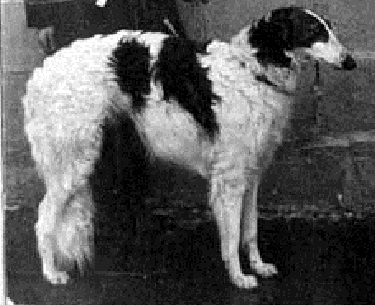
With these two admirable pictures of what a borzoi should be, I will proceed to quote the criticisms of what it is in this year of grace in England:
THE DUCHESS OF NEWCASTLE – I think we have quite as good specimens, and, on the whole, sounder than are to be found in their native land, – owing, I expect, to our less severe winter. Light eyes are, I am afraid, becoming too common, and breeders here think too much of size, getting with it flat sides and want of depth in chest. (Subsequently, aftering seeing the proofs of this article, Her Grace added these notes): Luckily very few specimens of the borzoi came from the Czar’s kennels; his borzois, as a whole, are a particularly bad collection. It was the Grand Duke Nicholas who sent Mr. Cremiere over in February 1892 with a team of some twenty borzois, Oudar and his litter brother and two sisters being the best of the bunch. I thoroughly disagree with the statement that the borzoi is less sagacious than other dogs, and consider that in the criticisms of his sense and temper he has been much maligned. I have had fourteen years intimate friendship with perhaps three hundred borzois, and have come across no fools amongst them. Every one I have taken into the house, even including imported mature specimens that have been used for wolf-hunting, have been good-tempered, intelligent companions, absolutely devoted to me, and well able to take care of themselves. And during my experience of them I have not had a bad fight in my kennels. They are also easily taught tricks. As really faithful companions, they are first among breeds. A borzoi 30 inches in height should girth at least 35 inches, and the taller the dog the deeper in proportion the girth should be. This should prove to all borzoi breeders the great importance of not going for leggy, weedy animals; as far as height goes, the tall ones, at first sight, impress any one not really knowing the breed before the smaller but much heavier dog; but the judge who goes for height before heart room is doing his best to ruin the breed. Dogs from 29 to 32 inches are the best – bitches from 28 to 31. It is really only within the last ten years that the breed has become popular and quite common, but it may interest those who do not know it that the borzoi was known in this country as far back as 1863, when a dog, Katai by name, bred by the Czar, was shown at Birmingham. In 1869 H.R.H. the Prince of Wales showed a specimen at Islington. Lady Emily Peel was the next borzoi fancier, then Lady Charles Innes Kerr, Colonel Wellesley, and Mrs. Alfred Morrison. After this I came on the scene in 1890, and borzois have increased since then all over England.
MR. R. HOOD-WRIGHT – I am not satisfied with type as it exists today. I think we are losing sight of the original use of the dog, and sacrificing type to coat, size, and length without breadth in head; consequently they are losing brain-power and intelligence.
MISS HELEN ARNOLD – Taken as a whole the borzois just now lack the dark eye so characteristic of the breed, and the silky curly coat so prized by Russians. Also more attention should be given to heads and general soundness. Many think the silky curly coat wrong in a borzoi, but it is amongst the chief points in a Russian hound, as it clings closer to the body, and keeps out the weather (silk is warmer than wool). Others think that the borzoi should have ribs like a weather-board; a proper borzoi’s ribs are sprung, so that his heart has room to beat and his lungs to expand. When they are bred like this we shall not hear of so many dropping down dead after galloping. Dogs should have good arch, the bitches less. English breeders want bitches with as much arch as a dog, and are apt to say of really good bitches, “She lacks arch.” The borzoi’s arch should give his back a rounded appearance – not the “spikey” look so many have. No point values are given in the Club’s book; if I had to draw up a scale I should assess them – Head, including eyes, ears and expression, 20; neck, shoulders, and fore-legs, 20; body between shoulders and hips, 20; hindquarters and hind legs, 20; coat, tail, and general type, 20; total – 100. (Miss Helen Arnold also exercised over my insufficient appreciation of the borzoi’s character, and adds to her notes): – I agree with your notes criticising the intelligence of the imported borzoi. In Russia, of course, they are trained to be savage as possible, and are essentially hounds, not pets, and all the conversation they are treated to is the whip. An English bred borzoi, e.g., one that has been “talked to” and treated kindly, is as intelligent as any other breed of dog, and has a much longer memory than some. I will admit there are some strains that will not civilize, and have given the breed its bad name in this country. I carefully avoid them. Part of my ambition has been realised: I have just sold one of my strain of borzois to a Russian nobleman for breeding. Russian breeders may not like the new (English) disposition of the borzoi, and may call them “lap dogs!” My imported bitch, before she learnt English and took to domestication, could and would attack anything; but she soon learnt to obey, and became the most gentle with every one.
MRS. J.M’INTYRE – There are so many types of borzois that the question of satisfaction as regards type is difficult to answer. No two judges judge alike, and not one judge in ten is consistent in his judging throughout the classes. Borzois should be judged by their points, and points alone; we should then have on and the true breed. There is no use in having point values when the dogs are not judged by them.
MAJOR BORMAN – There appears to be a tendency on the part of too many judges to go for size, without taking quality sufficiently into consideration; and more attention should be given by breeders to getting the long, lean head so characteristic of the borzoi. The following is, roughly, my idea of what point values ought to be – Head and expression, 20; legs and feet, 20; loin, 15; coat, 10; eyes, 5; tail, 5; girth and general symmetry of outline, 20; total – 100.
The recommendations of the borzoi are infinite. The Duchess of Newcastle thinks “they have most charming dispositions, most affectionate to their masters, and although prefectly civil to strangers don’t make a fuss over them. They are, I consider, the most faithful of any breed of dog I have personally come in contact with, and are certainly the most handsome.” Miss Helen Arnold likes them as a breed “for their size, beauty, and symmetry, and because, for ladies’ dogs, they are not too heavy to handle, can follow horse or person, yet be contented and comfortable in a room.” Mr. Hood-Wright deems them “beautiful and graceful, and the bitches make charming companions; but the dogs natural instinct is to chase – consequently many of them are not desirable companions off the lead.” Mrs. M’Intyre thinks them “the most elegant of dogs; good friends and good companions, and very tractable. When reared properly they are very hardy. I like them best of any dogs; they are always sweet and clean, and free from the objectionable odour so many dogs have.” Another lady-fancier writes: “Borzois seem to come truer to type than any other breed, and to pay for getting the best blood, and using the best sires. If – but that is a big ‘if’ – you can get them over distemper, they are very ornamental, affectionate, and – jealous. For all intents and purposes they are pet-dogs in England; they never knock over furniture or ornaments in a drawing room; but otherwise they are stupid, and not always good-tempered under punishment, which is frequently necessary from their in-bred habit of chasing everything. But they are so graceful and so insinuating that one forgives them much. No doubt where they are kept for real sport they are different animals. One thing greatly in their favour is that they have no ‘doggy’ smell, which especially fits them for the house.”
The Borzoi Club, of which the Duke and Duchess of Newcastle are joint Presidents and the Marquis of Bath Vice-President, is one of the three institutions whose secretarial duties Mr. Hood-Wright so admirably conducts. The membership is over fifty, the annual subscription a guinea, and it possesses two twenty-five and two fifteen-guinea challenge cups. The following is the description of the hound given in the Club’s publication: –
STANDARD OF POINTS OF THE BORZOI
HEAD. – Long and lean. The skull flat and narrow; stop not perceptible, and muzzle long and tapering. The head from the forehead to the tip of the nose should be so fine that the shape and direction of the bones and principal veins can be clearly seen, and, in profile, should appear rather Roman-nosed. Bitches should be even narrower in the head that the dogs. Eyes dark, expressive, almond-shaped, and not too far apart. Ears like those of a greyhound – small, thin, and placed well back on the head, with the tips, when thrown back, almost touching behind the occiput.
NECK. – The head should be carried somewhat low, with the neck continuing the line of the back.
SHOULDERS. – Clean and sloping well back.
CHEST. – Deep, and somewhat narrow.
BACK. – rather boney, and free from any cavity in the spinal column, the arch in the back being more marked in the dog than in the bitch.
LOINS. – Broad and very powerful, with plenty of muscular development.
THIGHS. – Long and well-developed, with good second thigh.
RIBS. – Slightly sprung at the angle of the ribs – deep, reaching to the elbow, and even lower.
FORE LEGS. – Lean and straight. Seen from the front they should be narrow from side to side, broad at the shoulders and narrowing gradually down to the foot, the bone appearing flat, and not round, as in the foxhound.
HIND LEGS. – The least thing under the body when standing still, not straight, and the stifle slightly bent.
MUSCLES. – Well distributed and highly developed.
PASTERNS. – Strong.
FEET. – Like those of the deerhound – rather long. The toes close together and well arched.
COAT. – Long, silky (not woolly); either flat, wavy, or curly. On the head, ears, and front legs it should be short and smooth. On the neck the frill should be profuse and rather curly. On the chest and rest of body, the tail and hidnquarters, it should be long. The fore legs should be well feathered.
TAIL. – Long, well-feathered, and not gaily carried.
HEIGHT. – At shoulder of dogs, from 28 inches upwards; of bitches, from 26 inches upwards.
FAULTS. – Head short or thick; too much stop; parti-coloured nose; eyes too wide apart; heavy ears; heavy shoulders; wide chest; “barrel” ribbed; dew claws; elbows turned out; wide behind.
The hounds considered most typical in the breed include Champions Velsk, Tsaritsa, Kieff, Statesman, Zeneitra, Volno, Vikhra, and Selwood Olga, and I have selected the first-named for illustration.
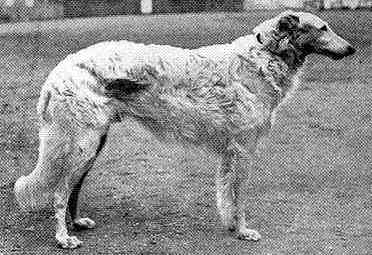
Ch. Velsk was bred and is owned by H.G. the Duchess of Newcastle. His sire was Korotai, and his dam Ch. Vikhra, and he was whelped in December 1895. He stands 31 inches high, weighs 114 lbs., and is white in colour with silver-grey markings. He has very dark eyes, well carried ears and stern, and is the heaviest coated dog on the show-bench; also the strongest boned. He is absolutely perfect in expression. The photograph is a first-rate one, and shows the dog in his best coat; “but,” writes his owner, “as nothing in the world is perfect, I should like to see Ch. Velsk a shade shorted in the back, and with a trifle more arch; otherwise I can find no fault.” Velsk is the winner of eleven championships and seventy-six first prizes, and has sired an immense number of winning progeny, amongst them being Champions Tatiana, Velsk, Votrio, Knois, and Theodora; and he was the sire of the four borzois exhibited with great success by H.M. the Queen in 1903.
Year of Event:
Country:
Personal Collections:
Source:
Author:
Dogs:
Persons:
